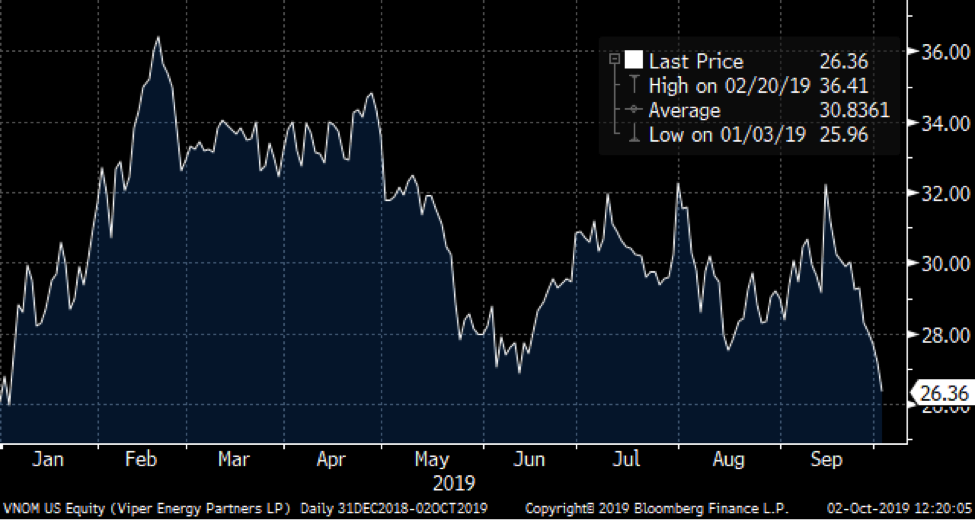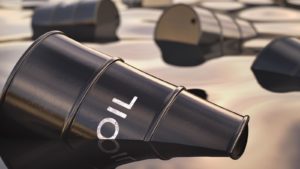Editor’s note: This column is part of our Best Stocks for 2019 contest. Neil George’s pick for the contest is Viper Energy Partners (NASDAQ:VNOM).

VNOM stock was my stock pick for the 2019 InvestorPlace Best Stocks Contest. The stock is from an upstream oil and gas company that is significantly different from other upstream companies in that it doesn’t explore or produce an ounce of petroleum — nor does it own any wells.
Instead, the company owns valuable land in the prime parts of the Permian Basin which is largely based in West Texas. It then in turn leases out the land to a collection of exploration and production (E&P) companies and collects rent and royalties on the oil and natural gas produced by its tenants.

As you can see in the price chart for the year to date. The stock was on a tear in the first quarter, leveled out and then fell into the second quarter and has been trading between around $26 to $32 per share since.
With the ample dividend currently yielding 7.11% which comes from the leases and royalties, the stock has returned 10.81% through the first three quarters — losing 8.79% in the third quarter. I see this stock performance disconnected from the underlying company’s business performance. Instead, the overall oil and gas market has been more responsible over the shorter terms.
With this said, let me present my take on the oil and gas market and then I’ll discuss the financial performance of Viper and show you why it is a bargain buy for great dividend income.
Petroleum is a Global & Not Just a U.S. Market
Petroleum demand is all about the globe and not just the U.S. While the US economy continues to expand with 2019 projected to see overall growth in the gross domestic product (GDP) at 2.50%, the rest of the globe continues to suffer. The Organization for Economic Cooperation & Development (OECD) has revised further downward GDP estimates for all of 2019 and for 2020 for the globe overall.
This slowdown in the globe’s economies is impacting the petroleum markets. To start, global oil demand is slowing down with less global economic growth. The current daily world demand for crude oil according to data from the International Energy Agency (IEA) is now running at 99.66 million barrels per day (MBPD) which is down from the fairly strong and continued demand under way for the past six years alone.
Meanwhile, supplies of crude oil are firmly stronger. Despite implemented production cuts by the Organization of Petroleum Exporting Countries plus others including Russia (OPEC+) as well as impaired supplies from embattled production from West and Northern Africa, Venezuela and the sanctioned Iran daily supply is now running at 101.22 MBPD with IEA data. And within OPEC+, data for Russian production for September show that it pumped more than its quota. And there has been another OPEC member quitting the cartel as Ecuador joins Qatar as independent nations not beholden to quotas.
But the big demand and supply imbalance comes largely in part from the additional supply from the U.S. The U.S. — thanks to incredible technological investment and deployments particularly in shale fields — continues to surge. Monthly production soared over the past six years by some 66.24%. This has made the U.S. the largest petroleum producer, outpacing Saudi Arabia and Russia.
Prices Will Vary
Crude oil prices were down during the fourth quarter of last year with US West Texas Intermediate (WTI) down tom $76.41 in early October to a low in December of $42.53. And global Brent crude prices fell from $86.29 to $50.47 for the same period.

With the resumption of the U.S. stock market, both WTI and Brent recovered into later April. But since then, overall slowed global growth and expectations for growth have sent prices lower. The exception came with the recent attack on the primary Saudi crude processing plant which prepares crude oil from field production on its way to marine export terminals. This sent traders to buy crude spiking prices. However, while I am projecting that the rebuilding will take months and not weeks based on conversations with folks with experience in Saudi Arabia — the overall supplies are still outpacing slowed demand as noted above.
This means that oil isn’t a growth market right now or for a while, until a global economic recovery and advancement commences.
Meanwhile, natural gas remains subdued in price. Right now, prices in the U.S. are running at $2.26 per million British Thermal Units (MBTU) which is down significantly from recent highs last November at $4.84 MBTU.

U.S. production of natural gas continues to surge over the past three years by 37.14%. And exports of US natural gas thanks to increasing capacity of liquified natural gas (LNG) processing and export terminals is up 4,832%. This should continue to expand into 2020 despite the narrowing price gap between US natural gas cost and LNG imported prices in Europe and Asia — again reflecting slowing economies.
So, we have a lot more supply of both crude and natural gas including LNG — particularly from the U.S. and a globe which is demanding less at more subdued prices. This is leading to the need to take a different stance on the stocks in the energy markets.
Up, Down & Midstream
The overall energy market in the US has been lagging the general stock market. The S&P 500 Energy Sector Index has only returned 1.22% year to date. That includes the bit of the rebound from the end of August into September. This reflects the challenges not just for the underlying companies throughout the sector, but the expectations from investors and the market of further growth for energy.
Upstream companies, meaning exploration and production companies are being challenged. Most of the major companies have global operations which are in the front line of global woes.
The oil field servicing companies which provide support to onshore and offshore wells have continued to see reduced demand even before the slowdown in the market. With so much shale oil in the U.S., traditional fields are not justifying capital budget increases.
Downstream refiners in the U.S. are still working out challenges as well. First, many major coastal refineries were set up years ago to process crude from South America and the Middle East. Only very recently have they needed to transition to process lower-cost shale oil.
The midstream pipeline and related toll-takers is where profits continue to flow. The Alerian Midstream Energy Index tracks the pipeline companies inside the U.S. market. It has seen a total return year to date of 18.47% vastly outpacing the overall energy sector market.
Pipelines and related assets including gathering facilities from U.S. shale fields as well as marine terminals for the increasing exports of U.S. crude continues to find very strong demand.
Regulatory relief and reformation have allowed more efficient management of pipes as well as expanded capacity including new pipes. With the huge production from shale fields, pipelines have been expanding their capabilities to move crude oil and natural gas both for domestic consumption and ever more for export.
Now, let me concentrate on how the petroleum market is going to work out for Viper Energy and VNOM stock.
Viper Still Has Fangs Full of Income
As noted earlier, Viper is not an exploration and production (E&P) company, but rather it is a property landlord which leases its land to E&P companies. And in turn, the tenant E&P companies pay royalty interests to Viper.
Viper therefore doesn’t need to spend capital on field maintenance or pay for new wells or equipment. This means that it doesn’t have to hedge against oil and natural gas prices to cover capital expenditures and other costs.
And the company can be run with a lower headcount with less overhead, as it merely has to evaluate and manage its tenants to make sure that they are capable of delivering royalties and not at risk for disappearing much like for tenants of other property companies like real estate investment trusts (REITs).
Viper has generated a return through the first three quarters of 2019 of 10.81% — well outpacing the traditional E&P companies’ stocks.
It has also been expanding its properties thanks to its affiliation with Diamondback Energy (NASDAQ:FANG) which founded the company through a drop-down of property assets to Viper back in 2014.
Revenues over the trailing year are up at a robust rate of 67.90%. And as discussed above, with its business model — it is very efficient with operating margins running at 70.30%. And it shows in the return on the overall capital of the company running at 14.40%. It has piles of cash and very limited debts.
And it pays a dividend distribution of 47 cents per share which is up 3.36% from the trailing year — even with lower oil and natural gas prices. And that distribution is up over the trailing three years by an average of 36.31%. This yields a current 7.11%.
While lower oil and natural gas prices may bring lower or higher distribution amounts from quarter to quarter, the business model is very insulated for the given future of the markets.
And the proof can be found by looking at the distributions from revenues from the fourth quarter of 2018 and the first quarter of 2019 when crude prices were lower. Viper still generated cashflows for distributions of 51 cents and 38 cents respectively which would still provide an ample dividend yield even if crude prices slip further to lows seen late last year.
The Bottom Line on VNOM Stock
So, while not necessarily a growth stock for the near-term unsettled energy market – Viper is a very good dividend stock for the longer haul. And with the stock now discounted in price, it is valued at a mere 2.08 times book value.
And that book value of its very hard to replace assets including its Permian land holdings continues to advance strongly each quarter from June of 2016 to the most recent increasing by 2.38 times to a current $12.74 per share. And with further drop downs of land assets from Diamond Bank expected – this should continue to rise. This means that the underlying value of the company behind the stock should indeed keep growing.
So, with ample and rising dividend income and rising underlying value of its company – the stock is one of the only upstream companies in the petroleum market that is a bargain to buy right now.
Now I’ve presented my continuing case for dividend income and underlying growth in value from Viper Energy, perhaps you might like to see more of my market research and recommendations for further safer growth and bigger reliable income. For more – look at my Profitable Investing.
In addition, I have recently had a book published titled Income for Life. For more information on it click here. It is nearly 400 pages of income producing investment strategies for all weather economic conditions as well as additional income producing ideas that anyone can use successfully.
Neil George is the editor of Profitable Investing and does not have any holdings in the securities mentioned above.
